BOXED IN: The Connection Between Wari Mortuary Complexes and Inka Textiles
by Katie Elizabeth Ligmond
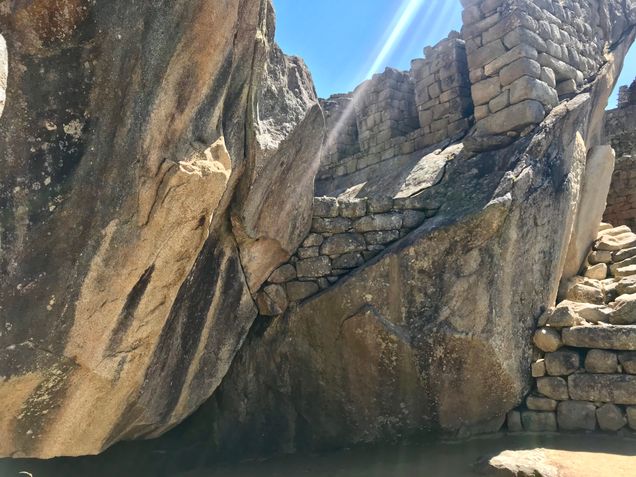
Before the Inka were a glimmer in the cosmos, the Wari Empire dominated the Central Andes, spreading out from their capital in the Ayacucho Valley, north through the majority of the modern-day country of Peru, and south toward the contemporary Bolivian border. While today the Inka’s fame eclipses that of the Wari, the latter were perhaps formers’ direct ancestors, laying their imperial foundations eight hundred years before the Inka arrived in Cusco. Indeed, much of Inka imperial construction is both conceptually and physically built upon Wari foundations. In fact, the fundamental system of Inka control, a labor taxation system recorded on knotted strings called khipu, appears to be a revival of a Wari system, a technique found nowhere else in the Andes.1
However, there appears to be a major difference in the way the Wari and the Inka built their empires in the most literal sense. Wari and Inka architecture are dramatically different: the Wari attempted to conquer nature, while the Inka demonstrated that nature supports them. For example, the Wari site of Pikillacta was built on a strict grid, superimposed on the landscape without conforming to the undulations of the mountains underneath; the synthetic grid takes precedence over natural curvature.2 By contrast, the Inka fused their worked stones into natural rock formations, creating what art historian Carolyn Dean calls “integrated outcrops,”3 thereby allowing nature to literally support the Inka empire (fig. 1).
Comparing architecture to architecture, however, only reveals part of the picture; in comparing architecture to other media, the Wari legacy within Inka culture becomes readily apparent. In this paper, I postulate that Wari architectural complexes, particularly elite mortuary complexes, provide the geometric grid that the Inka used in their textiles. I believe understanding how the grid functions in both Wari and Inka material culture is central to understanding the organization of their empires. Primarily, in both Wari architecture and Inka works of art, the grid is presented as a means of obfuscation. It provides order for imperial elites, but denies access to commoners.

The Wari were likely the first empire in the Andes, building outward from their capital in the city of Huari.4 The Wari civilization expanded until about 900 CE before disappearing in a cacophony of shattered ceramic offerings and burned complexes. This collapse of the Wari Empire occurred about five hundred years before the Inka began their expansion. The Inka likely moved to the Cusco Valley in the mid-1300s CE, but only began conquering their neighbors around 1400 CE. Their empire was expanding until the arrival of the Spanish in 1532 CE. The terms “Wari” and “Inka” are both ethnic and national markers; both empires incorporated groups that were ethnically dissimilar from their own. The Inka certainly viewed subjects of non-Inka ethnicity as lesser, and evidence suggests the Wari also held this bias against those outside their ethnic group.5 Given the temporal distance between these two civilizations, it is unlikely that the Inka knew of the Wari directly, but Wari governmental strategies appear to be embedded in Andean ontologies. In addition to the khipu discussed earlier, both the Wari and Inka are known to have created intricate, highly standardized textiles for their elites. In addition, the Inka occasionally built directly upon Wari foundations. One such example is the Inka repurposing of a Wari aqueduct to build a gateway at the site of Rumiqolqa.6
As empires, the governmental structures of both the Inka and the Wari were preoccupied with the justification of their rule through the artificial creation of a power imbalance. The power imbalance is visible primarily in the comparison of the material culture of elites and commoners in these empires, with the elites demonstrating extreme wealth and control in a variety of ways. The Wari in particular emphasized power through city construction. As I have stated, the Wari grid superseded nature. Hills often undulate under Wari walls without disrupting the sharp geometric rectangles of the city walls and homes.7 Nature could not break the Wari grid.

Wari cities suffocate the outsider. They exist as incomprehensible, opaque, and chaotic. Wari cities—to the foreigner, the rural commoner, the modern tourist—are unnavigable. Firstly, the Wari enclosed their cities within extremely high walls. Today, the peripheral site of Pikillacta has walls reaching about fifteen feet in height, although at the time of construction they were surely much taller (figs. 2, 3). Plaster remains at Wari cities suggest that the walls were a blinding white, which would have been exacerbated by the sharp Andean sun (fig. 4). Inside these walls, the city had no roads and all structures were agglutinated in “patio groups” (fig. 5). Each patio group consisted of a courtyard surrounded by small, rectangular buildings. Thus, there were only two ways to move through the city: by crawling along the dizzyingly high walls or by moving through the patio groups and, therefore, likely walking through citizens’ homes. Archaeologist William Isbell has suggested that visitors to Wari may have faced “humiliating confusion.”8 But would the inhabitants of such interiors have felt the same way?
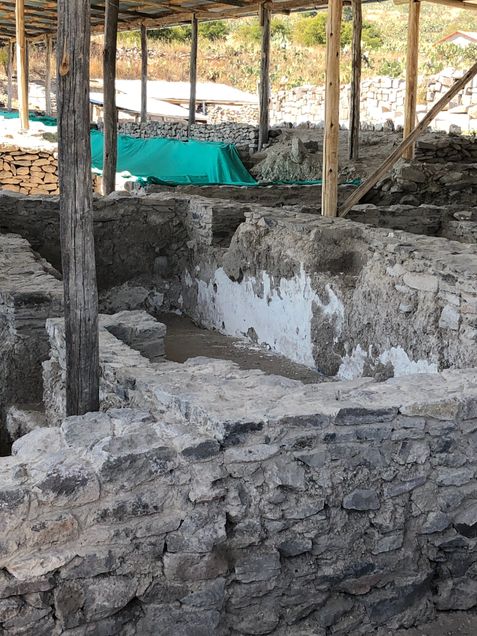
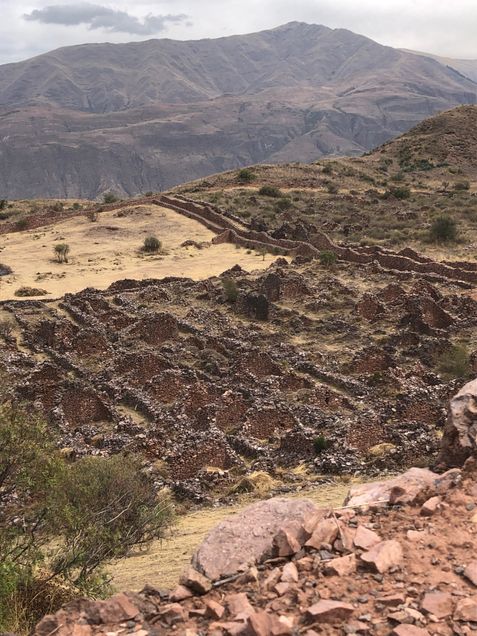
While visitors, servants, or the rural citizens living on the outskirts may have experienced panic at the thought of walking through a Wari city, elites knew that they held the key to understanding the city’s logic.9 In fact, elites seemed to feel so confident in their knowledge of their towns that they constructed their mortuary sites according to the same logic, desiring to rest forever in a similar place.10 The most elite Wari resting place is located within Huari, and built as a “Megalithic Monumental Internment,”11 a term used to describe extremely large, stone burial complexes (fig. 6).12 From above, the complex mimics a patio group; it is also constructed of rectangular walls built directly next to one another. The relationship is not one to one, but the geometric organization is strikingly similar. Mortuary complexes also include additional subterranean levels, which form a kind of “catacomb” that extends about thirty feet underground.13 They are likely the direct inverse of a Wari wall, which would have stood at about this height.
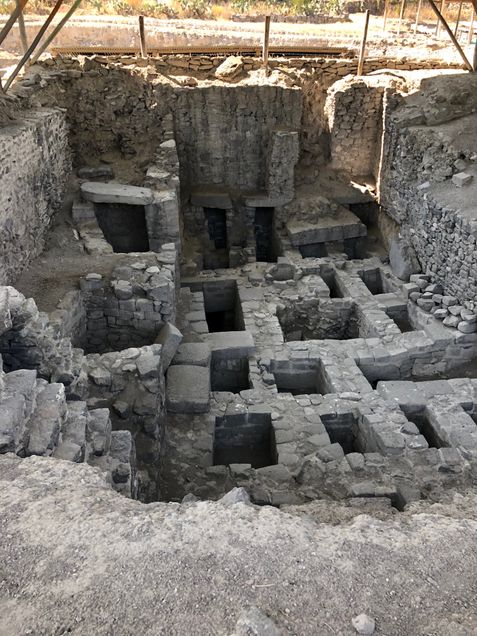
Thus, it appears that there was a logic to Wari cities, one only comprehended by the upper echelons of Wari society. I argue that this was a common strategy across imperial Wari art, in which the organizational principle understood by elites was unknown to the majority of people. For example, Wari textiles often obfuscate major cult figures in an attempt to alienate their citizens from the details of the subject matter while still hinting at the iconographic importance.14 The clue here may be in the grid pattern that the Wari constructed. This grid is carried across various Wari art forms: The patio group forms a kind of distorted grid of rectangles, some larger than others, arranged around a central core. Similarly, Wari textile patterns utilize rectangles to form heavily abstracted figures (fig. 7). The mortuary complex also mirrors this pattern; it is composed of rectangles of varying sizes that are roughly organized into rows and columns.
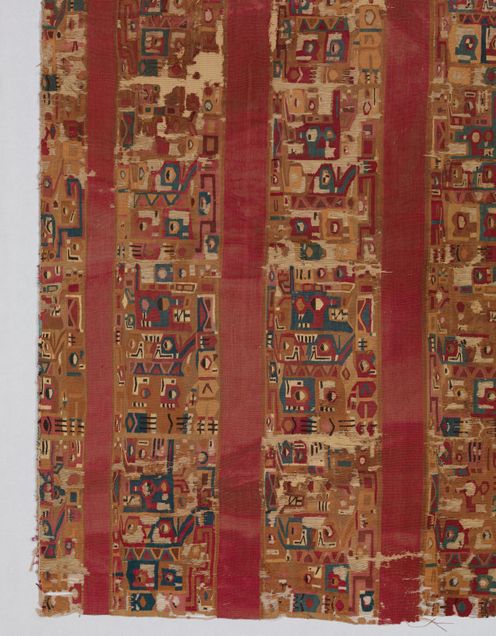
I borrow this association between Wari textiles and architecture from art historian Rebecca Stone and archaeologist Gordon McEwan. In their seminal piece on the subject, they argue that both patio groups and elites’ tunics are built using an “additive mode of production.” In other words, both a textile and a wall are built “row by row” from the ground up.15 Further, both elite textiles and Wari complexes contain what Stone and McEwan call “anomalies.” In architecture, these anomalies include curved walls. In textiles, they occur as a change in the expected color pattern.16 Thus, there is an element of chaos that exists across Wari works of art, breaking expected patterns. By orchestrating the construction of these chaotic elements, elites further denied commoners’ access to the underlying logic. It is worth noting as a well that both textiles and architecture are “lived in” spaces. Elites chose to spend their entire lives in their organized chaos, within a system only they could comprehend. They could work in this world of confusion, choosing to wear dramatic colors and to wander through the confusing halls of Wari cities, in life and in death.
This idea of an organizational code, known only to elites but suggested through the construction of a grid, reappears in Inka textiles. The patterns on Inka men’s tunics are fully abstract. They are composed completely of tokapu, geometric shapes inscribed in rectangles. Traditional tokapu could only appear in a few places: on a garment’s waistband, along the yoke, and vertically down the center. In only one case may tokapu cover the garment completely: when worn by the emperor (fig. 8).17 Tokapu patterns and organization were recorded in colonial texts, but their meanings seem to have only been known to the most elite of Inka society. Even fairly contemporaneous Indigenous writers were unable to record their messages.18 Textile historian Mary Frame has observed one clue: tokapu are often organized into four parts,19 likely a reference to the Inka empire which was aptly named Tawantinsuyu, meaning “four parts together.”20
The tokapu therefore hint at the organization of the empire, without giving direct information about it. The Inka elite demonstrated their control over this system of organization by aligning tokapu in neat rows and columns, suggesting that, while the knowledge that these symbols encode may not be known to the public, the elite were able to manipulate them effectively.
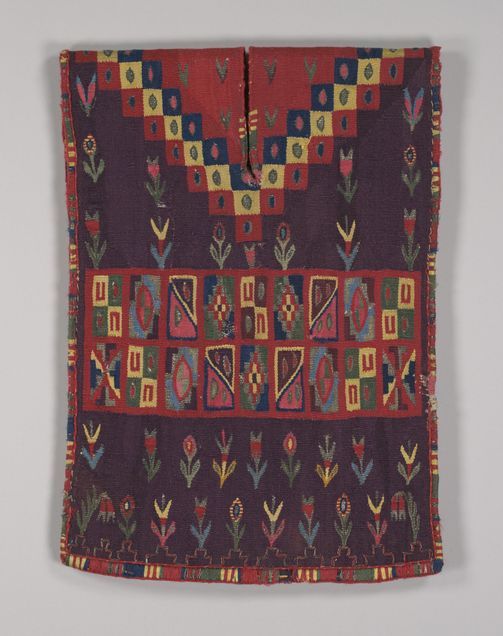
It is important to note that Inka society was built on an intense hierarchy based in complementarity. The archetypal complementary pair exists as a heterosexual married couple, a q’ariwarmi, literally meaning “man-woman.” Men and women were both necessary for the continuation of life and society. Both were important and valuable, but men had a higher status in Andean society. The Inka borrowed this core structure and amplified it: both state and citizen are important and valuable, but the state has a higher status.21 The role of the state–embodied by the Inka elite—was to comprehend the organization of the cosmos, record it on textiles, and give orders; the role of the citizen was merely to follow orders. This is demonstrated in Inka architecture as well. Recall the integrated outcrop: the state-sponsored, built world of Inka stone exists on top of the outcrop, the natural rock gives itself over to support the structure.
Thus, I propose a connection in this imperial method of confusion that begins in the Andes with the Wari built environment and continues in the making of Inka tokapu. In broader terms, this suggests that confusion is a potentially powerful imperial model, one we should watch with vigilance lest it seep into the present.
____________________
Katie Elizabeth Ligmond
Katie Elizabeth Ligmond is a PhD student of Visual Studies at the University of California, Santa Cruz. She researches Andean empires, primarily how textiles functioned within imperial ideology. She also studies world Catholic traditions, ethnic survival under imperial domination, and women’s roles in the development of states.
____________________
Footnotes
1. R. Alan Covey, “The Inca Empire,” in The Handbook of South American Archaeology, ed. Helaine Silverman and William H. Isbell (New York: Springer, 2008), 825; what is particularly interesting about khipu is that in all of the Andes, only the Wari and the Inka are known to use them. They seemingly disappear around the year 900 CE and are picked back up by the Inka. It is impossible to say how the Inka knew about them, or whether both groups used khipu in the same way.
2. Gordon F. McEwan and Patrick Ryan Williams, “The Wari Built Environment: Landscape and Architecture of Empire,” in Wari: Lords of the Ancient Andes, in Wari: Lords of the Ancient Andes, ed. Susan E. Bergh (New York and Cleveland, OH: Thames & Hudson and The Cleveland Museum of Art, 2012), 66.
3. Carolyn Dean, “The Inka Married the Earth: Integrated Outcrops and the Making of Place,” The Art Bulletin 89, no. 3 (September 2007): 504.
4. The capital of the Wari empire is also called “Wari.” Archaeologist William Isbell frequently uses the old spelling of the word “Huari” to refer to the capital, and “Wari” (the modern spelling) to refer to the culture. I adopt this strategy here.
5. The Inka were extremely focused on ethnic difference, assigning symbols and garment styles to each particular group so that identity could be noted at a glance. In my opinion, Wari textiles do not demonstrate this kind of boundary setting. However, the Wari would sacrifice children from the periphery, creating trophy heads with the skulls. This suggests that the Wari were certainly interested in instilling fear in peripheral areas, and likely understood these people to be less important than ethnic Wari citizens. For a discussion, see Tiffany A. Tung and Kelly J. Knudson, “Childhood Lost: Abductions, Sacrifice, and Trophy Heads of Children in the Wari Empire of the Ancient Andes,” Latin American Antiquity 21, no. 1 (March 2010): 44–66.
6. William H. Isbell and Margaret Young-Sánchez, “Wari’s Andean Legacy,” in Wari: Lords of the Ancient Andes, ed. Susan E. Bergh (New York and Cleveland, OH: Thames & Hudson and The Cleveland Museum of Art, 2012), 253; it is perhaps worth noting here, that the Wari site of Pikillacta, is directly across the street from the Inka site of Rumiqolqa.
7. Rebecca Stone-Miller and Gordon F. McEwan, “The Representation of the Wari State in Stone and Thread: A Comparison of Architecture and Tapestry Tunics,” Res: Anthropology and Aesthetics 19/20 (1990/1991): 61–2.
8. William H. Isbell and Alexei Vranich, “Experiencing the Cities of Wari and Tiwanaku,” in Andean Archaeology, ed. Helaine Silverman (Oxford, UK: Blackwell Publishing, 2004), 180.
9. There are a plethora of burial types in Wari cities, that range from extreme wealth to relative poverty, suggesting that there were some commoners that lived within the city. (See William H. Isbell and Antti Korpisaari, “Burial in the Wari and the Tiwanaku Heartlands: Similarities, Differences, and Meanings,” Diálogo Andino 39 (2012): 91–122). However, the kinds of luxury goods available to all persons living within the complex, by virtue of feasting, were unmatched outside the compound. Certainly, servants lived within city walls, and would be considered “commoners,” but there is no way of knowing how freely they could move through the city. (See, for more information, Donna Nash, “The Art of Feasting: Building an Empire with Food and Drink,” in Wari: Lords of the Ancient Andes, ed. Susan E. Bergh (New York and Cleveland, OH: Thames & Hudson and The Cleveland Museum of Art, 2012), 82–101). Therefore, “commoners” certainly lived within the city, but they were likely better off (at least in terms of food and access to prestige goods) than rural commoners, and likely had some basic knowledge of the city, but I doubt they understood the ideological processes at play. When I refer to “commoners” in this paper, I am generally referring to those people that lived entirely outside the city, who lived without any access to elite life.
10. It is impossible to say what the Wari believed happened to them in the afterlife. The Inka mummified their ancestors, so that they could interact with the dead as though they were alive, but Wari deceased are not mummified, and thus I believe they expected to rest for eternity.
11. “Megalithic Monumental Internment” is a term William H. Isbell uses to describe Wari royal burials, see Isbell and Korpisaari, “Burial in the Wari and the Tiwanaku Heartlands,” 96.
12. Isbell and Korpisaari, “Burial in the Wari and the Tiwanaku Heartlands,” 99.
13. Ibid., 99.
14. I have discussed the obfuscation of cult figures in Wari textiles in-depth elsewhere, primarily here: Katie Elizabeth Ligmond, “Deliberate Confusion: Abstraction as Iconoclasm,” Annual Symposium of Latin American Art through the Institute for Studies on Latin American Art (April 2019).
15. Stone-Miller and McEwan, “Wari State in Stone and Thread,” 54.
16. Ibid., 59.
17. John Howland Rowe, “Standardization in Inca Tapestry Tunics,” in The Junius B. Bird Pre-Columbian Textile Conference (May 19th and 20th, 1973), eds. Ann Pollard Rowe, Elizabeth P. Benson, and Anne-Louise Schaffer (Washington, DC: The Textile Museum and Dumbarton Oaks, 1979), 242.
18. Both John H. Rowe and Mary Frame discuss the value of colonial documents, but note that colonial informants seem to not have full information about the meanings of tokapu. Felipe Guaman Poma de Ayala, a man of mixed Indigenous heritage writing in the early 1600s, is one of the primary sources on the function and use of Inka textiles. He does not, however, seem to have concrete understanding of tokapu messages. For a complete discussion, see Rowe, “Standardization in Inca Tapestry Tunics” and Mary Frame, “What Guaman Poma Shows Us, but Doesn’t Tell Us, About Tukapu,” Ñawpa Pacha: Journal of Andean Archaeology 30, no. 1 (June 2010).
19. Frame, “What Guaman Poma Shows Us,” 32.
20. Gordon F. McEwan, The Incas: New Perspectives (New York: W.W. Norton & Company, 2008), 44.
21. For a discussion on Inka co-opting of Andean family structures see: Irene Silverblatt, “Imperial Dilemmas, the Politics of Kinship, and Inca Reconstructions of History,” Comparative Studies in Society and History 30, no. 1 (January 1988): 83–102.